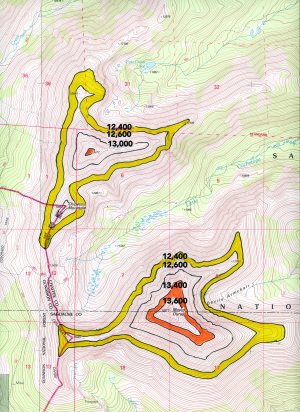By George Sibley
It was a moderately surreal event: 80 people gathered on top of Monarch Pass on the Continental Divide in early January (sunny, temperature 9 degrees), around an altar carved out of the deep snowbanks, on which were arranged icons of the Eastern Orthodox Church.
We were there to “bless the waters” that, when spring comes, flow from that divide east into the Arkansas River and west into the Gunnison and Colorado Rivers. Most of those present were the priests and the faithful from several Orthodox congregations along the Front Range on the Eastern Slope and Delta on the Western Slope. Orthodox churches globally celebrate the “Blessing of the Waters” as part of Epiphany events marking both the coming of the Wise Men to Jesus’ birthplace and the baptism of Jesus years later in the Jordan River.
Also present were a sprinkling of pagans like myself; but given that the Greek origin of “baptize” is “immersion in water,” some of us pagans were well baptized in more secular water issues – an engineer from Colorado Springs Utilities on the Eastern Slope, and a couple of us from the Upper Gunnison River District on the Western Slope, two organizations that have a history of contention over the ultimate east or west destiny of water originating in the Upper Gunnison. But that was back in the good old days when there was still at least the illusion of unappropriated water on the Western Slope. Today, most Eastern Slope water organizations acknowledge that there is not enough available water in the Upper Gunnison to warrant a multi-billion-dollar tunnel, storage and delivery system.
So now we Colorado water buffaloes are mostly baptized under our own new epiphany about the future: an emerging belief that, confronted with inexorable population growth on the one hand, and a probable reduction in water supply due to climate change on the other hand, we can only meet this challenge by working together. So we have collaboratively developed a four-decade state water plan, and have committed ourselves to juggling, redistributing and using more efficiently what water we have so that, like the Biblical miracle of the fishes and loaves, the water supply we have now might someday serve up to twice the current multitude.
[InContentAdTwo]
You can maybe see why this “adaptive management” water plan (meaning work it out as you go) might as well be described in religious as political or economic terms: it is an act of faith, if only in ourselves to do better than we have. And while we were celebrating the water already there on the pass, we were also thinking something similar to prayer for the water that we hope will come, oh come, oh winter snow. Affirm our hope that maybe the first 15 years of the 21st century, with average flows down almost 20 percent from the 20th-century average, may not be “the new normal” but just an abnormal drought: faith, brethren and sistren, faith!
Going back down the pass to Gunnison that day, related thoughts were rattling around in my undisciplined mind. I began contemplating the vast array of other miracles that enabled us to go 40 miles from downtown Gunnison to the top of Monarch Pass and back before lunch. Begin with the beautiful machine we were riding in, a bubble of warm comfort in the subzero valley temperature, and the massive systems that produce such machines; add in the sprawling system that processes black goo from deep in the planet into the fuel powering our beautiful machines, delivered dependably even into the cold heart of the Rockies; and all this happening on smooth, plowed, paved roads, through some of the best of what the unimaginative call “God’s Country.”
Spanish philosopher Jose Ortega y Gasset (in The Revolt of the Masses) spoke contemptuously of the European masses who he believed considered such things as “motorcars” and the highways they ran on, all of which were there when said masses were born, as things “placed at their disposition like the air” they breathed, elements in “the natural scheme of things” – in other words, gifts of the gods to be taken for granted like natural things, and not something which humans were responsible for creating – and maintaining.
I don’t think of myself, or the readers of this usually intelligent magazine, as being so deluded as that. But we have entered a time in which the distinction between “the works of the gods” and “the works of humankind” is blurring. The snow that falls on Monarch Pass this winter will bear traces of soot from China, and the amount of snow and the timing and amount of usable runoff may well reflect a “new normal” rather than an abnormal drought, due to the amount of formerly stored fossil carbon we have put back into our atmosphere.
And I do see in myself a kind of a disconnect between what I know about all this in an intellectual way, and what I tend to do about it in a daily way. For example, I am convinced by the evidence of good science that we need to reduce our carbon consumption dramatically over the next several decades if we want to avoid the probability of some drastic climate changes altering the way the planet works. I have known this for a quarter century now – a third of my life – supposedly the most mature and responsible part of my life.
But what have I done about “dramatically reducing my own carbon consumption”? I do more fair-weather miles on the bicycle around town; we start a wood fire in the morning (in-cycle carbon) rather than asking the gas furnace (fossil carbon) to warm up the house from the overnight temperature; I’ve tried to adjust my inner clock so I can’t say, well, I’ll be late if I don’t drive …. But beyond a few things like that, I’ve not done much. If it looks like rain, I drive. Over a quarter century I have managed maybe a 5 to 10 percent reduction in my hulking, all-American carbon footprint.
What I’m mostly doing about this, I guess, is indulging in a very American faith that, somehow, science, technology and industry will come to our rescue – that by mid-century we will have the electric auto! And it will be affordable! And the electric power for the auto, and everything else, will come not from dirty old fossil fuels, but from renewable solar and wind resources! And inexhaustible nuclear fusion energy!
Yes, nuclear fusion is back in the news – remember “energy too cheap to meter” back in the 1950s, when we were dreaming ahead to “The Year 2000”? In the 1950s “The Year 2000” was a kind of invocation for people (me, credulous adolescent, among them) who believed we shouldn’t have to die to go to heaven; we could have it here on earth. Nuclear fusion then was twenty years away; it is still twenty years away. But keep the faith, baby!
Is it going too far to suggest that “the American Dream” is, was,and ever shall be a religion for the people of the planet, a faith grounded in innovative technology and industrial organization? We have, for a fact, tried to globalize American ideas and ideals, much as the Roman Catholics tried (with some success) to globalize Catholicism throughout the expanding world in medieval times. They with the cross and sword; we with Coca-Cola capitalism and airpower. Small-c “catholic” means “universal in extent, involving all”; we continue to want to make catholic our American faith in our mashup of democracy, free markets, unlimited resources, science, technology and industry.
Well, I have wandered far afield from the Blessing of the Waters up on Monarch Pass, the cold heart of Central Colorado. But I’ll go a little further before coming home again: to Paris, December 2015, when leaders of most of the world’s nations, including our own, pledged to (paraphrasing here) do their best to significantly reduce their carbon emissions in, well, the coming years, decades, whatever. It was, as has been often said by glass-half-full analysts, better than nothing.
But how do we do this? How do we decarbonize an energy-intensive and heavily consumptive civilization that is built upon the burning of carbon fuels? The alternatives that could conceivably sustain us in our current blessed but fragile state of abundance are hard to imagine; the transition to such alternatives is even harder to imagine – especially when we realize that we are the ones who will have to change or be changed. If our scientists and engineers cannot figure out how to power civilization-as-we-know-it-now affordably without carbon energy, can we envision ourselves beginning to live without the beautiful machines and highways and comfortable well-lighted homes, and all the other blessings that seem as “natural” and omnipresent in our environments as the mountains and rivers? Faith, brethren and sistren: miracles do, or can, or might happen, if we keep faith in our “American exceptionalism.”
George Sibley thinks too much in Gunnison.


